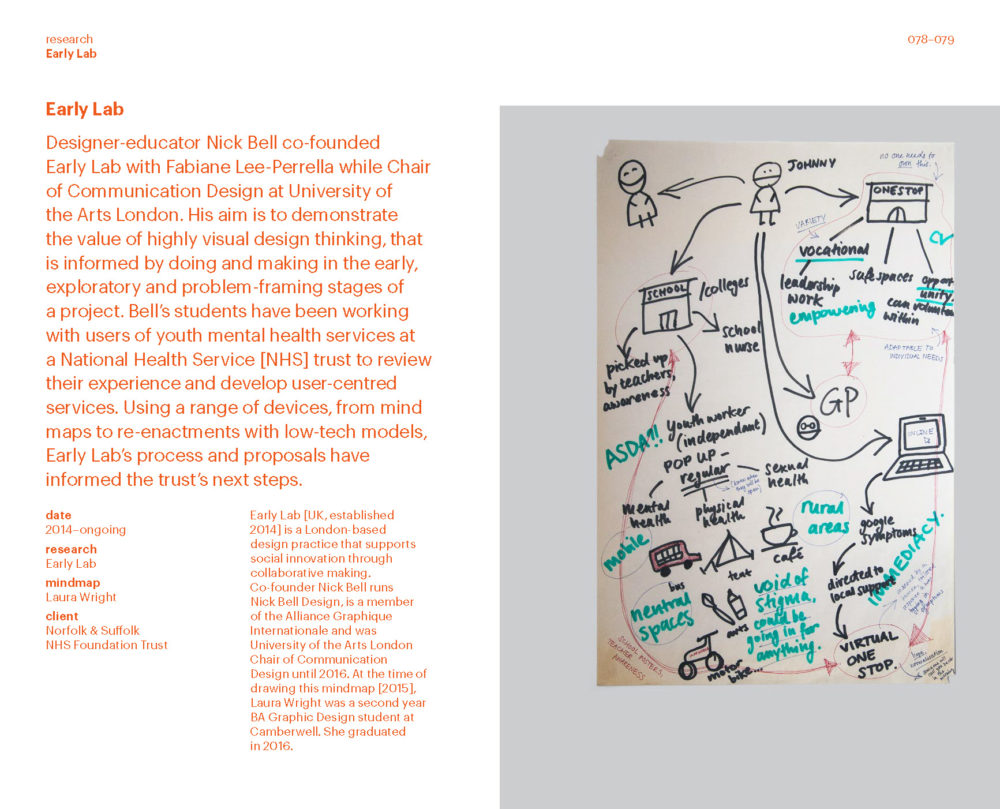Early Lab is featured in a Wellcome Collection exhibition about the relationship between health and design.
An exhibition exploring the relationship between health and graphic design has featured Early Lab's work done in collaboration with Norfolk and Suffolk NHS Foundation Trust (NSFT). Displayed is one of the stories charting the experience of accessing mental health services created jointly by NSFT service providers and members of Early Lab's student team. It is an example of the use of a proxy process – a story plotted and made visual in a 3-hour workshop – designed specifically to elicit empathy in service providers for those who might find themselves in the position of carer for a young person enduring mental ill health.
The exhibition runs from 7 September 2017 to 14 January 2018 at the Wellcome Collection, Euston Road, London.
Wellcome Collection: “Comprising over 200 objects including hard-hitting posters, illuminated pharmacy signs and digital teaching aids, ‘Can Graphic Design Save Your Life?’ will consider the role of graphic design in constructing and communicating healthcare messages around the world, and will show how graphic design has been used to persuade, to inform and to empower.
This exhibition will highlight the widespread and often subliminal nature of graphic design in shaping our environment, our health and our sense of self. Drawn from public and private collections around the world, it will feature work from influential figures in graphic design from the 20th century, as well as from studios and individual designers working today.
‘Can Graphic Design Save Your Life?’ is curated by graphic designer Lucienne Roberts and design educator Rebecca Wright, founders of publishing house GraphicDesign&, with Shamita Sharmacharja at Wellcome Collection”. https://wellcomecollection.org/graphicdesign
Below is the A1 size storyboard, created during Early Lab’s field trip in 2015, featured in the exhibition.

A book has been published by GraphicDesign& to accompany the exhibition. In it the curators ask featured designers and contributors to respond to the question, can graphic design save your life? Below is an unedited version of Nick Bell’s response.
You save lives by making life worth living, by making a world all kinds of people can see a future for themselves in.
Making a world that nurtures everyone’s very different aspirations is however enormously difficult to achieve. This is partly because public institutions are configured to respond to crises after the event. For example, health services are deployed primarily after a person becomes unwell; justice is meted out primarily after a crime has been committed; rehabilitation and reconciliation are advocated primarily after sentencing; public enquiries get commissioned primarily after a disaster.
Traditionally, the discipline of design has conformed to this after-the-event model. In this service mode, it is as if there would be no design to do if there were no client briefs to answer, so fixated and dependent have designers been on the ‘solving’ of ‘problems’ framed by a commissioner as their source of purpose. Times are changing though. Design is in the process of becoming much more than the practice, called upon to iron out the glitches, that renders smooth passage for business-as-usual.
Design is no longer limited by the so-called solving of so-called problems: what has come to be known as the execution of short-term fixes. Design is also imagination, long-term vision and through emergence, transformation. Design is becoming more about the creation of futures everyone can see them self in.
This is an aspiration that will not be achievable though if designers are not members of a broad trans-disciplinary community embedded in a system instituted to act before events. After all, events are merely surface symptoms of a deeper reality. Designers, together with practitioners from many other fields of practice – whether arcane or everyday, industrial or domestic – must advocate preventative behaviours whilst engaging in the deeper reality. For example, health services so a person is less likely to become ill; justice, rehabilitation and reconciliation so a crime is less likely to be committed; public policy and regulatory protections so a disaster is less likely to happen.
This trans-disciplinary thinking and doing, (that needs to be taking place a lot more if preventative action is to be committed to far enough in advance of potential crises), is less likely to materialise without design. Design is more than just a discipline. It is a meta-discipline: a source of integration for all other fields of practice.
Can graphic design save your life? Yes, it can, but not by itself. No single domain of expertise can, not even medicine. It would be hubris for any one field of practice to make that claim. With everyone working together though, in cooperation despite all our differences (or rather, because of them), there is a better chance that it can.



